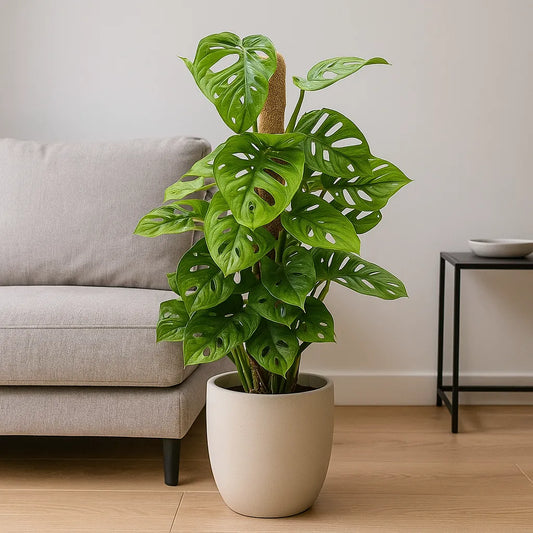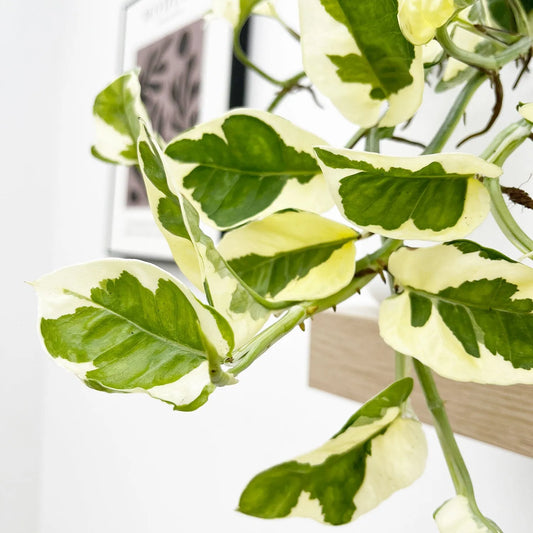Colocasia vs Alocasia
Due to their similar looks, the Colocasia and Alocasia plants are often confused with each other. The leaves and colouring of these tropical houseplants are so similar to each other that even veteran plant growers can struggle to tell the difference. In this guide we give you all the knowledge you need to tell the difference between Colocasia and Alocasia plants.
What is a Colocasia plant?
Colocasias are tropical perennial plants which are also known as Elephant Ear or Taro. They are native to Southeastern Asia and India and are selected for their ornamental characteristics.The leaves of Colocasia are large and plain-green. They are usually a rounded, bowling ball shaped and tend to point downward. Colocasia leaves tend to be covered in prominent veins and will often come to a point at the end.
Colocasia plants require full sun for the best growth. Compost-rich soil is the best choice for the Colocasia. You must make sure that your soil can hold onto water, but be well-draining enough to prevent the roots sitting in standing water which can kill them.
What is an Alocasia plant?
Alocasia is a species of stunning tropical plant that has traditional arrowhead-shaped leaves with glossy surfaces. These broad-leaved plants grow from central tuber instead of a seed which means it will come back every year. There are 97 known species in this genus and they are native to tropical and subtropical Asia and eastern Australia.
Alocasia are very fast growing plants that are chosen for their stunning foliage that can become the centerpiece of any room in your home.
If you have children or pets in the house you need to be careful if you own an Alocasia as it is toxic to humans and animals. However if you handle your plant correctly and put it in a safe place you should be able to avoid any problems.
Differences between Alocasia and Colocasia
Leaves
The best way to tell the difference between these two plant species is to look at the leaves. Though both plants have very large leaves and are sometimes called Elephant Ears, they have distinct differences in their leaves. The leaves of the Alocasia are upward-facing and stand up horizontally. On the other hand, Colocasia leaves tend to point downward.
The leaves of the Alocasia have a shiny surface that is thick, waxy and glossy in texture.They are primarily dark green but they are also seen in shades of almost black with a silvery sheen. The leaves of the Colocasia have a matte finish and have a slightly rougher texture. They are mostly green in color, but have plenty of variation. There are also black-leaved Colocasia, black-spotted, glossy, matte-leaved varieties.
Petioles
The petiole is the stem that attaches the leaf to the main stem of the plant. If you cannot get a clear identification from just looking at the leaves this can be another way to spot the difference. The petioles of the Alocasia extend into the leaves and because of this the leaves follow the line of the petioles. The petioles of the Colocasia connect down from the notches in the leaves..
Tubers
Unlike most plants, the Colocasia and the Alocasia do not grow from seeds. Instead they grow from a small tuber or bulb. You can differentiate between Alocasia and Colocasia by looking at the tuber or bulb of these two plants. Colocasia tubers are large and swollen and encircled by striped bands. The tubers of Colocasia are also known as “taro” and are used for food in Hawaii. Alocasia tubers are smaller, thin and plain without the prominent stripes or eyes.
Height
Most varieties of Colocasia grow between three to ten feet, but have been known to vary in size from 8 inches to over nine feet. Alocasia varieties are smaller than Colocasias with their average height being between two to six feet.
Growth
Both of these Elephant Ear plants are popular and prized for their fast growth. These tropical plants grow faster in the hotter and more humid weather. Alocasia plants can grow very fast in the right condition and have been known to grow at a rate of three to five feet per year. Colocasia varieties tend to grow faster and are known to grow between four and eight feet a year.
Why knowing the difference matters
Even though these plants look very similar, they are different species. It can be common for most houseplant owners to treat all their plants the same, especially when they have similar characteristics. Doing this can have detrimental effects on your plants and can easily lead to them dying early or not growing at their best. Here are some of the main care differences between Alocasia and Colocasia plants:
Light
Alocasia varieties need shade to full sunlight depending on the variety. If the plants grow in brighter light conditions, the leaf color tends to be better. On the other hand, Colocasia grows best in full sun exposure.
Watering
Both plants need frequent watering. Colocasia needs almost aquatic conditions with plenty of water. They can be grown in standing water. Alocasia plants should be kept moist all year round, but will require less water during the winter and they cannot be grown in standing water.
Soil
Colocasia plants like compost-rich soil. It thrives in wet soil but does not like staying wet in the wintertime. That’s why it needs compost-rich soil that does not stay wet in the wintertime. Alocasia plants require loose, well-drained potting mix or crumby loamy soil. They need soil that doesn’t stay soggy. If they are planted in a very wet location for a long time it causes root rot.
Use as food
Parts of these plants are edible, but with important differences. Many Colocasia varieties are grown for their edible tubers, called Taro. Taro is an important food crop in Hawaii, where Colocasia is widely cultivated. Most varieties of Alocasia are not edible. Some are highly poisonous and eating them could be fatal so knowing what plant you have is doubly important if you are attempting to create your own Taro.
A few Alocasia varieties have edible stems, as opposed to the edible tubers of Colocasia. The stems of these select varieties must be specially prepared to avoid gastrointestinal upset. As the edible Alocasia varieties are grown mostly by agricultural concerns, it is likely that most nursery plants are non-edible varieties.
Take a look at our full range of houseplants and find the perfect plant for your home today.











1 comment
Any advice
Also in same pot for 14 years
Leave a comment
Please note, comments need to be approved before they are published.